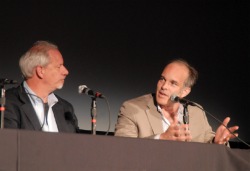
(Photos © J. Maus)
If aliens dropped into the free screening of PBS’s documentary Beyond Motor City at the Bagdad Theater Tuesday night, they would have gotten a crash course in America’s transportation history and the challenges we face as a nation to recover from our love affair with highways and automobiles.
Unfortunately, they would have also come away without knowledge of one of the most obvious solutions to that recovery — the bicycle.
The documentary, just one film in PBS’s ambitious and award-winning Blueprint America series, followed the rise and fall of Detroit from a transportation perspective yet it made no mention of how bicycling might figure into the ailing city’s future.
“Bicycles were pushed to the margins in this film for political reasons, which we can discuss later.”
— Aaron Woolf, director
Speaking before the film, director Aaron Woolf said Detroit, “Cast its lot with the automobile in a bad way” and said their commitment to cars didn’t pan out because they mistakenly “were looking into the future of a country that would be dominated by petroleum.”
Like many U.S. cities, Detroit developed rapidly during the first half of the last century due to improved access by waterways (Erie Canal), roads, trains and later streetcars. Then, car companies began to grow and their influence helped spur what the film referred to (rather innocently) as “the rise of the automobile.” (Several car companies were found guilty by the federal government for conspiring to dismantle streetcar systems in Detroit and many other cities — but the film did not mention that.)
This “rise” led to auto-centric planning and an urban landscape dominated by freeways and parking lots. To make room, planners displaced entire neighborhoods and razed hundreds of homes and buildings. In the film’s most powerful moment, a Detroit minister speaks fondly about the neighborhood he grew up in and how it completely vanished when a freeway was built nearby.

the panel discussion.
According to the film, the city lost its vitality in large part because so much public space had been given to cars and public transit system was dismantled. This environment contributed to isolation and tensions that led to riots in 1967 that left 43 people dead and marked the beginning of a long period of urban decay.
In the film, Detroit — with a whopping 40% of its space lying fallow — is described as a “blank canvas” with the potential to retool and reinvent itself as a city of the future.
That future, as portrayed in the film, would be devoid of bikes and would instead be full of plug-in cars (the film felt like a commercial for Ford Motor Company in several segments) zooming to high-speed train stations and light rail lines criss-crossing the city.
Why would biking not even merit a mention in a film about the future of transportation in America?
After all, Detroit is relatively flat, has a network of paved, low-traffic (at least for now) roads — perfect conditions for bicycling to flourish. They’ve also got a burgeoning bike scene as evidenced by these photos and report on Streetsblog from a (successful and peaceful) Critical Mass ride just last week that had 375 riders. Not to mention, Detroit is home to the first paved road in the nation, a road that was paved by bike advocates as part of the ‘Good Roads’ movement at the turn of the 19th century.
The reason we didn’t see bikes in the film was surprising and should serve as a warning flare to bike advocates across the country.
During the Q & A session that followed the screening, director Woolf said, “Bicycles were pushed to the margins in this film for political reasons, which we can discuss later.”
After the panel, several people approached Woolf. He elaborated on his comment to say that he filmed a lot of biking segments but that he had a “hard time getting PBS to take bicycling as transportation seriously.”
I followed up with Woolf via email. He confirmed that he filmed, “a number of scenes that might have helped add a thread of biking to the overall narrative” including footage of Detroit’s bike collective “The Hub” and the opening of the Dequindre Cut greenway, but he didn’t put the blame on PBS producers like he had so clearly last night:
“I should take as much blame as anyone for the fact that we couldn’t get those scenes into the overall arc. Faced with a looming deadline and too much material, it was hard to integrate biking into the three hundred year transportation history the film attempts to survey – though this would have been my preference, as both an urban bicyclist and someone who elected to shoot those scenes in the first place.”
Whatever the reason, the absence of bicycling in Beyond Motor City is a shame. It’s a missed opportunity not just for people who care about the future of Detroit, but for every city where a break from our auto-centric past is imperative. PBS is backing a national screening tour of this film, and given the importance and relevance of this topic, it would have been an excellent educational vehicle for how bicycling infrastructure is the best investment cities can make.
For people that care about biking, this should serve as a a cautionary tale. It’s just the most recent sign that the political muscle behind light rail and streetcar infrastructure (and the funding that follows) is currently way ahead of bike infrastructure and there’s a real threat that biking will continue to be left on the cutting room floor unless that changes.
Special thanks to PSU’s Oregon Transportation Research and Education Consortium and local non-profit Architects Without Borders for hosting this free screening. Pretty neat to live in a town where a film like this draws a nearly sold-out crowd.

